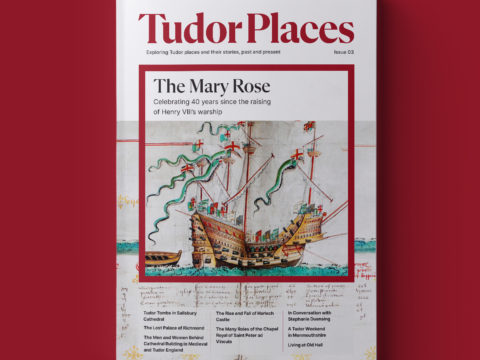Discovering Tudor London
This deceptively slim volume, ideal for a bag or pocket is packed with historical facts and visitor information for more than 20 palaces, houses, churches and religious houses in London associated with the Tudors that can still be visited today.
Discovering Tudor London is a curated, rather than all-encompassing, guide and in the Introduction Grueninger sets out her principles for choosing the sites: buildings associated with or built by the Tudors; museums and galleries housing treasures from the period; sites where there is something substantial left to see; and places that are open to the public.
Her choices are impeccable – a mix of the well-known, 'must-haves' of the Tower of London, Westminster Abbey and Hampton Court Palace, the lesser known, such as Lambeth Palace, Eltham Palace, and the Guildhall and hidden gems such as the London Charterhouse, Sutton House and St Dunstan-in-the-West, now a late Georgian/early Victorian building, but one that accommodates the only known surviving statue of Queen Elizabeth I carved during her lifetime. The latter is an example too, of the author’s detailed knowledge of these sites, which permeates the book.
This knowledge is strongly reflected in Part I, which contains a series of itineraries, for 3, 5, 7 and 10 day visits and a list of necessities (Oyster Card, Tube map, Historic Royal Palaces card, comfortable walking shoes etc) for making a modern “Tudor London pilgrimage”. The itineraries are user-friendly and carefully thought out, taking into account the visitor’s time available, the vagaries of opening hours at some sites and the logistics of travelling around London, whilst ensuring all itineraries, even the shortest, include the 'must-see' attractions.
Parts 2 (Houses, Halls, Palaces and Castles) and 3 (Churches and Religious Houses) comprise an alphabetical listing of comprehensive information for each site. This includes material on the historical features of the site (short history, what it would have looked like in the sixteenth century, key events that occurred there) and practical information for the visitor (contact details, nearest tube station, opening hours etc). The historical features sections are extensive, especially for the major sites, and provide fascinating detail – these are no brief overviews of well-worn facts.
The decision to include museums and galleries that contain Tudor treasures is a wise one and Part 4 not only reminds us of the wealth of these institutions in London but rounds out the Tudor London experience. Full descriptions of the key Tudor artefacts to be found in each museum or gallery, and their exact location, help to counter what can sometimes be an overwhelming experience when first entering these buildings.
This guide is full of images with lovely historic maps and engravings, alongside a number of photos, many from the author’s own collection, of the sites today. Unfortunately, all images are in black and white, indeed the whole book is black and white. Whilst this works for the historic illustrations, it is disappointing not to see the modern images, at least, in colour. This is probably the publisher’s decision, but it is a shame not to have more colour in this guide overall, not only to reflect the colour of the subject but to complement the excellent research and writing.
Clearly written as a practical guide for the visitor to London, this thoughtfully-constructed and well-researched book is a great resource for anyone with an interest in Tudor London.
Tudor Times received a review copy.




